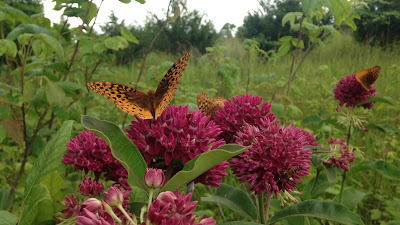Yesterday, before the storm, the butterflies and the bees were congregating around the milkweed flowers. I could not help wanting to see them, and I crowded in as close as I could to get a better look. I got a touch of poison ivy for my trouble.
Even when the wind picked up, the Great Spangled Fritillary butterflies were hanging on for dear life.
The bumblebees and the honey bees were buzzing about. But the butterflies kept on with their task, undismayed by the weather.
I expect that the Great Spangled Fritillaries will still be here in late August or early September. Last year I spotted them on the thistle flowers, their wings frayed and torn with not much more wear left in them, but still visiting every flower they could until the very end.
 |
| A Great Spangled Fritillary Butterfly with frayed wings seen in September of 2014 Source: http://notesfromthepens.blogspot.com/2014/09/conflict-of-interest-and-artificial.html |
Some people migrate and some people stay put. Then when they meet again, sometimes they forget that they are all sprung from some common source,
This animated map shows how humans migrated across the globe.
Posted by Business Insider on Thursday, May 21, 2015
 |
| Bow was born in Missouri, but he has ancestors from Africa |
I think the same kind of convoluted thinking about ethnicity that allows only some American-born humans to be called "African American" when everyone has ancestors from Africa is also at play in labeling chimpanzees as exotic animals. Bow is American-born, while I am an immigrant from another country. Bow's mother was also American-born. At what point does an animal stop being labeled exotic? Why should it matter where our ancestors were born? Didn't all of us come from the same place anyway?








No comments:
Post a Comment